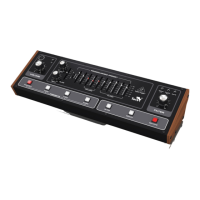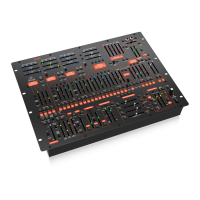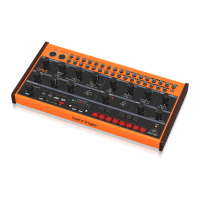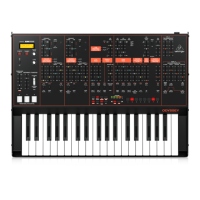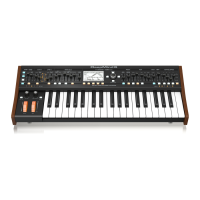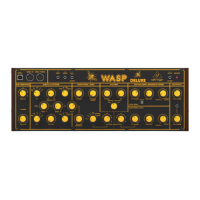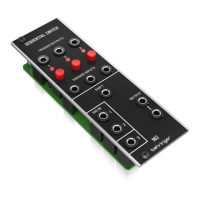(EN) Step 2: Controls
Synthesizer Section
(1) TUNE - adjust the frequency of the internal VCO oscillator,
approximately one octave either side of center.
(2) CUTOFF - adjust the cuto frequency of the low-pass VCF
lter. Frequencies above the cuto will be attenuated,
such as the higher-order harmonics.
(3) RESONANCE - adjust the amount of emphasis given to the
signal level at the cuto frequency.
(4) ENVELOPE - select the depth of modulation applied by the
envelope generator to the VCF cuto frequency.
(5) DECAY - control the amount of time taken for the envelope
to decay from the current level to minimum.
(6) ACCENT - adjust the amount of accent given to the output
for any notes programmed with an accent.
Patchbay (3.5 mm TS input and output
connections)
(7) FILTER IN - this input allows the connection of an external
audio signal instead of the internal VCO oscillator.
(8) SYNC IN - this input allows the use of an external clock
and start/stop signal.
(9) CV OUT - control voltage output of 1V/octave.
(10) GATE OUT - gate output.
(11) PHONES - connect your headphones to this 3.5 mm
TRS output. Make sure the volume is turned down
before putting on headphones.
Distortion Section
These controls only have an eect when the DISTORTION switch
(20) is ON. The circuit is located in the signal path just before the
volume control and the nal audio output.
(12) DRIVE - adjust the amount of distortion.
(13) TONE - adjust the tone.
(14) LEVEL - adjust the distortion output level.
General Controls
(15) TEMPO - adjust the rate at which the pattern and
tracks play, from slow to fast.
(16) WAVEFORM - select the waveform of the internal VCO
oscillator from reverse sawtooth or pulse.
(17) TRACK/PATTERN GROUP - select from TRACK 1 to 7 when
writing or playing tracks, and PATTERN GROUP I, II, III, IV
when writing or playing patterns. Patterns in group I are
only available for use in track 1 or 2, patterns in group II
for tracks 3 or 4, group III for tracks 5 or 6, and group IV
for track 7.
TD-3 Controls
(18) MODE - select from Track Write, Track Play, Pattern Play,
Pattern Write.
(19) POWER LED - indicates that power is supplied to the unit
and the rear-panel power switch is on.
(20) DISTORTION ON/OFF - when OFF, the distortion is
bypassed, and the DRIVE, TONE, and LEVEL controls have
no eect.
(21) VOLUME - adjust the output level from the rear-panel
output and the headphones output. Make sure the volume
is turned down before putting on headphones.
Sequencer Section
(22) D.C./BAR RESET/CLEAR - this is used to clear a pattern
from memory, to return a track to the beginning, and to
signal that the last pattern is being added to a track.
(23) PITCH MODE - selects the pitch mode on or o. The LED
will light when in pitch mode. This mode is used to enter
the notes when creating patterns.
(24) 13-NOTE KEYBOARD - these switches are laid out as a
13-note keyboard, allowing notes to be selected when
creating patterns. The lower eight switches are also used
when creating, saving, and selecting patterns and tracks.
(25) TIME MODE LED - the LED will light when in TIME MODE.
(26) TIME MODE ON/OFF - select the TIME MODE on or o.
This mode is used when entering the timing (note, tie,
or rest) after the notes have been entered in PITCH MODE.
(27) BACK - when stepping through a pattern, this allows
you to select the last played note, so it can be edited.
This switch and WRITE/NEXT (35) are used to view and
change SYNC and CLOCK settings.
(28) START / STOP - this allows you to start or stop playing the
patterns and tracks. The LED will turn on when playing.
(29) FUNCTION - this multipurpose switch is used to return
the TD-3 to normal mode from PITCH MODE and TIME
MODE, and for various operations during pattern and
track writing.
(30) NORMAL MODE LED - this LED will light when the unit is
in normal mode.
(31) TRANSPOSE DOWN/NOTE/STEP - this is used to
transpose the octave downwards in PITCH MODE, enter a
note in TIME MODE, and to enter the number of steps in
a pattern.
20
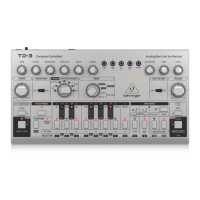
